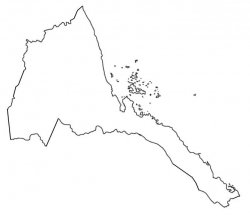
أجهزة الملاحة العربية
Your way to more knowledge
Product successfully added to your shopping cart
Quantity
Total
There are 0 items in your cart.
There is 1 item in your cart.
Total products
Total shipping
To be determined
Total
- Countries of the World
- Zip code in Jordan
- List of surahs in the Holy Qur'an
- All flags of the countries of the world
- Traffic signs in Jordan
- Population of world countries by country
- List of world capitals
- Car Brand Logos and Names
- International Calling Codes
- List of currencies of the world
- Country flags of the world with images and names
- Country codes names
- List of countries and dependencies by area
- Al-Quran Recitations mp3
- List of countries and dependencies by population
- World time zones by country
Eritrea
Official name: State of Eritrea
Also known as: Ertra, Tigrinya, ሃገረ ኤርትራ (Tigrinya), إريتريا (Arabic)
Capital of Eritrea: Asmara
Area of Eritrea: 117,600 km² (45,406 mi²) (100th)
Population of Eritrea: 3,535,603 (132th) - (2024 est.)
Location: Eastern Africa, bordering the Red Sea, between Djibouti and Sudan
Languages of Eritrea: Tigrinya (official), Arabic (official), English (official), Tigre, Kunama, Afar, other Cushitic languages
Religions of Eritrea: Sunni Muslim 37%-52%, Eritrean Orthodox 47%-63%.
Ethnic groups of Eritrea: Tigrinya 50%, Tigre 30%, Saho 4%, Afar 4%, Kunama 4%, Bilen 3%, Beja 2%, Nara 2%, Rashaida 1% (2021 est.)
Currency: Nakfa (ERN) Calling code: (+291)
Organizations: United Nations
Border countries (3): Djibouti 125 km (78 mi), Ethiopia 1,033 km (642 mi), Sudan 682 km (424 mi)
Coastline: 2,234 km (1,388 mi; 1,206 nmi) total
— mainland on Red Sea 1,151 km (715 mi, 621 nmi)
— islands in Red Sea 1,083 km (673 mi, 585 nmi)
Administrative divisions (6) regions (zobatat, singular - zoba):
Anseba, Debub (South), Debubawi K'eyyih Bahri (Southern Red Sea), Gash-Barka, Ma'ikel (Central), Semienawi K'eyyih Bahri (Northern Red Sea)
Natural resources: gold, potash, zinc, copper, salt, possibly petroleum and natural gas, fish.
Area of Eritrea: 117,600 km² (45,406 mi²) (100th)
Population of Eritrea: 3,535,603 (132th) - (2024 est.)
Location: Eastern Africa, bordering the Red Sea, between Djibouti and Sudan
Languages of Eritrea: Tigrinya (official), Arabic (official), English (official), Tigre, Kunama, Afar, other Cushitic languages
Religions of Eritrea: Sunni Muslim 37%-52%, Eritrean Orthodox 47%-63%.
Ethnic groups of Eritrea: Tigrinya 50%, Tigre 30%, Saho 4%, Afar 4%, Kunama 4%, Bilen 3%, Beja 2%, Nara 2%, Rashaida 1% (2021 est.)
Currency: Nakfa (ERN) Calling code: (+291)
Organizations: United Nations
Border countries (3): Djibouti 125 km (78 mi), Ethiopia 1,033 km (642 mi), Sudan 682 km (424 mi)
Coastline: 2,234 km (1,388 mi; 1,206 nmi) total
— mainland on Red Sea 1,151 km (715 mi, 621 nmi)
— islands in Red Sea 1,083 km (673 mi, 585 nmi)
Administrative divisions (6) regions (zobatat, singular - zoba):
Anseba, Debub (South), Debubawi K'eyyih Bahri (Southern Red Sea), Gash-Barka, Ma'ikel (Central), Semienawi K'eyyih Bahri (Northern Red Sea)
Natural resources: gold, potash, zinc, copper, salt, possibly petroleum and natural gas, fish.
note1: strategic geopolitical position along world's busiest shipping lanes; Eritrea retained the entire coastline of Ethiopia along the Red Sea upon de jure independence from Ethiopia on 24 May 1993.
note2: that the border between Eritrea and Ethiopia is disputed.

